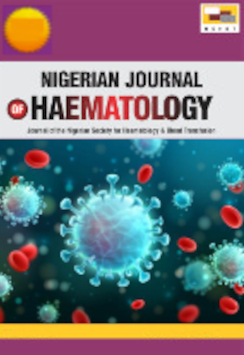Transfusion Services in Nigeria: Blood Banking Techniques and Availability of Facilities for Blood Component Therapy
Keywords:
component therapy, refrigerated centrifuge, blood typing methods, apheresisAbstract
Background: To determine blood banking techniques and availability of facilities for blood product preparations in Nigeria.
Aim and Objectives: To determine the safety of blood and blood products in blood banks in Nigeria; assess the availability of equipment and reagents; and the utilisation of resources to provide for the transfusion needs of our patients.
Materials and Methods: This was a descriptive cross-sectional study of some healthcare professional attendees at the 2018 Annual Scientific Conference of the Nigerian Society for Haematology and Blood Transfusion (NSHBT) in Calabar, Cross River State, Nigeria. A selfadministered, structured questionnaire to determine bloodtransfusion practice in Nigeria, was used to obtain demographic data of the participants, data on haemovigilance and the availability of resources for the preparation of safe blood and blood components in blood banks across Nigeria. Data was analysed using descriptive and inferential statistics and p≤ 0.05 defined the level of significance.
Results: A total of 93 (75.6%) participants responded to the questionnaire out of 119 professionals (consultant haematologists, haematology resident doctors and medical laboratory scientists). None of the participants used Gel-cards or microtitre plates for blood typing in their centres. Less than one fifth (19.4%) and 23.4% reported having either an apheresis machine or a refrigerated centrifuge respectively in their centres, while 25.8% had neither equipment. Majority (52.7%) reported non-functionality of available equipment. The commonest reason given for the nonfunctionality or non-usage of these machines were mechanical breakdown (46/49, 93.9%), lack of reagents (19/49, 38.8%), absence of uninterruptible power supply (17/49, 34.7%), and lack of trained personnel to operate the machines (11/49, 22.4%). All the participants reported nonavailability of cryoprecipitate, while 16.1%, 12.95%, and 12.2% reported availability of fresh frozen plasma, red cell concentrates, and platelet concentrates respectively. Majority (79%) of the participants that prepared platelet concentrates did so on demand, but did not store them.
Conclusion: Standard blood banking techniques, component therapy and facilities for component preparations are not readily available in most blood banks in Nigeria. Provision of modern blood banking equipment/materials, staff training, and uninterruptible power supply may ameliorate some of the observed drawbacks in blood transfusion services in Nigeria.
Downloads
References
Dean CL, Wade J, Roback JD. TransfusionTransmitted Infections: an Update on Product Screening, Diagnostic Techniques, and the Path Ahead. J Clin Microbiol 2018; 56:pii: e00352-18.
Schmidt AE, Refaai MA, Blumberg N. Past, present and forecast of transfusion medicine: What has changed and what is expected to change? La Presse Médicale 2016; 45:e253– e272.
Ambroise MM, Ravichandran K, Ramdas A, Sekhar G. A study of blood utilization in a tertiary care hospital in South India. J Nat Sci Biol Med 2015; 6:106–110.
Li L, Li KY, Yan K, Ou G, Li W, Wang J et al. The History and Challenges of Blood Donor Screening in China. Transfus Med Rev 2017; 31:89-93.
Chevalier MS, Kuehnert M, Basavaraju SV, Bjork A, Pitman JP. Progress Toward Strengthening National Blood Transfusion Services — 14 Countries, 2011–2014. MMWR Morb Mortal Wkly Rep 2016; 65:115– 119.
Okoroiwu HU, Asemota EA. Blood donors deferral prevalence and causes in a tertiary health care hospital, southern Nigeria. BMC Health Serv. Res. 2019; 19:510. https://doi.org/10.1186/s12913-0194352-2
Barro L, Drew VJ, Poda GG, Tagny CT, Magdy ElEkiaby M, Owusu-Ofori S, et al. Blood transfusion in sub-Saharan Africa: understanding the missing gap and responding to present and future challenges. Vox Sang 2018; 113:726736.
Cohen R, Ning S, Yan MT, Callum J. Transfusion Safety: The Nature and Outcomes of Errors in Patient Registration. Transfus. Med. Rev. 2018; 33:78-83.
Fasano RM, Meyer EK, Branscomb J, White MS, Gibson RW, Eckman JR. Impact of Red Blood Cell Antigen Matching on Alloimmunization and Transfusion Complications in Patients with Sickle Cell Disease: A Systematic Review. Transfus Med Rev 2018; 33:12-23.
Jacquot C, Delaney M. Efforts Towards Elimination of Infectious Agents in Blood Products. J Intensive Care Med 2018; 33: 543-550.
Osaro E, Charles AT. The Challenges of meeting the blood transfusion requirements in SubSaharan Africa: the need for the development of alternatives to allogeneic blood. J Blood Med 2011; 2:7-21
Lund T, Hume H, Allain JP McCullough J, Dzik W. The blood supply in Sub-Saharan Africa: Needs, challenges and solutions. Transfus Apher Sci 2013; 49:416-421.
National Blood Transfusion Service. Federal Ministry of Health, Nigeria. Nigeria National Blood Policy Revised. Abuja: National Blood Transfusion Science, Federal Ministry of Health; 2006. p. 1–16
Blood Safety Fact Sheet. World Health Organization; 2011. Available at https://www.who.int/newsroom/factsheets/detail/blood-safetyand-availability.
Ketter PM, Kamucheka R, Arulanandam B, Akers K, Cap AP. Platelet enhancement of bacterial growth during room temperature storage: mitigation through refrigeration. Transfus 2019; 59:14791489.
Claudia S. Cohn, Beth H. Shaz. Warming Up to Cold-stored Platelets. Anesthes 2020; 133:1161– 1163
Hegde S, Akbar H, Zheng Y, Cancelas JA. Towards increasing shelf life and haemostatic potency of stored platelet concentrates. Curr Opin Hematol 2018; 25: 500–508.
Aneke JC, Ezeama N, Okocha CE, Onyeyili AN, Onah CE, Ibeh NC. Knowledge attitude and practice of haemovigilance among healthcare professionals in a Nigerian tertiary Hospital. Egypt J haematol 2017; 42: 108-116.
Mwangi JW, Kimani D, Odour M. Approaches to advancing blood safety through haemovigilance: A review. East Afr Med J 2009; 86: S93-S97
World Health Organization: National Blood policy. Available at https://www.who.int/bloodsafety/trans fusion_servic es/nat_blood_pol/en/. Accessed April 12, 2020.
Aneke JC, Okocha CE. Blood transfusion safety; current status and challenges in Nigeria. Asian J Transfus Sci. 2017; 11: 1–5.
Federal Republic of Nigeria: Revised National Policy — National policy on blood transfusion. Abuja, 2004. Available at https://cheld.org/wp content/uploads/2012/04/NigeriaRevisedNational-Health-Policy2004.pdf. Last accessed April 12, 2020.
Dahourou H, Tapko JB, Nébié Y, Kiénou K, Sanou M, DialloM. Mise en place de l’hémovigilance en Afrique subsaharienne. Transfus Clin et Biol 2012; 19: 39–45.
Ugwu A, Gwarzo D, Nwagha T, Gwarzo A, Greinacher A. Transfusions in limited infrastructure locations – where to go decades after safe blood initiatives by World Health Organization. ISBT Series 2019; 0:118.
Cheng, D, Hao, Y. Comparative Evaluation of the Microcolumn Gel Card Test and the Conventional Tube Test for Measurement of Titres of Immunoglobulin G Antibodies to Blood Group A and Blood Group B. J Int Med Res 2011; 39: 934– 943.
Mujahid A, Dickert FL. Blood Group Typing: From Classical Strategies to the Application of Synthetic Antibodies Generated by Molecular Imprinting. Sensors (Basel). 2015; 16(1)51. doi: 10.3390/s1601005 https://pubmed.ncbi.nlm.nih.gov/2672 9127/
Bhagwat SN, Sharma JH, Jose J, Modi CJ. Comparison Between Conventional and Automated Techniques for Blood Grouping and Crossmatching: Experience from a Tertiary Care Centre. J Lab Physicians. 2015; 7:96– 102.
Muhibi M A, Ifeanyichukwu M, Oluogun W A, Jeremiah A Z. Compromise in Rapid Test Kit makes it Unsuitable for Blood Transfusion Safety. Sokoto J Med. Lab. Sci. 2018; 3: 5-13.
Sakamoto S, Putalun W, Vimolmangkang S, Phoolcharoen W, Shoyama Y, Tanaka H, Morimoto S. Enzyme-linked immunosorbent assay for the quantitative/qualitative analysis of plant secondary metabolites. J Nat Med. 2018; 72:3242.
Elliot ED, Fareed A. Diagnostic accuracy of blood centers in the screening of blood donors for viral markers. The Pan Afr Med J. 2015; 20:119.
Szczepiorkowski ZM, Dunbar NM. Transfusion guidelines: when to transfuse. Hematol 2013; 2013: 638– 644.
Basu D, Kulkarni R. Overview of blood components and their preparation. Indian J Anaesth 2014; 58: 529-37.
Downloads
Published
Issue
Section
License
Copyright (c) 2023 Nigerian Journal of Haematology

This work is licensed under a Creative Commons Attribution-NonCommercial-NoDerivatives 4.0 International License.








